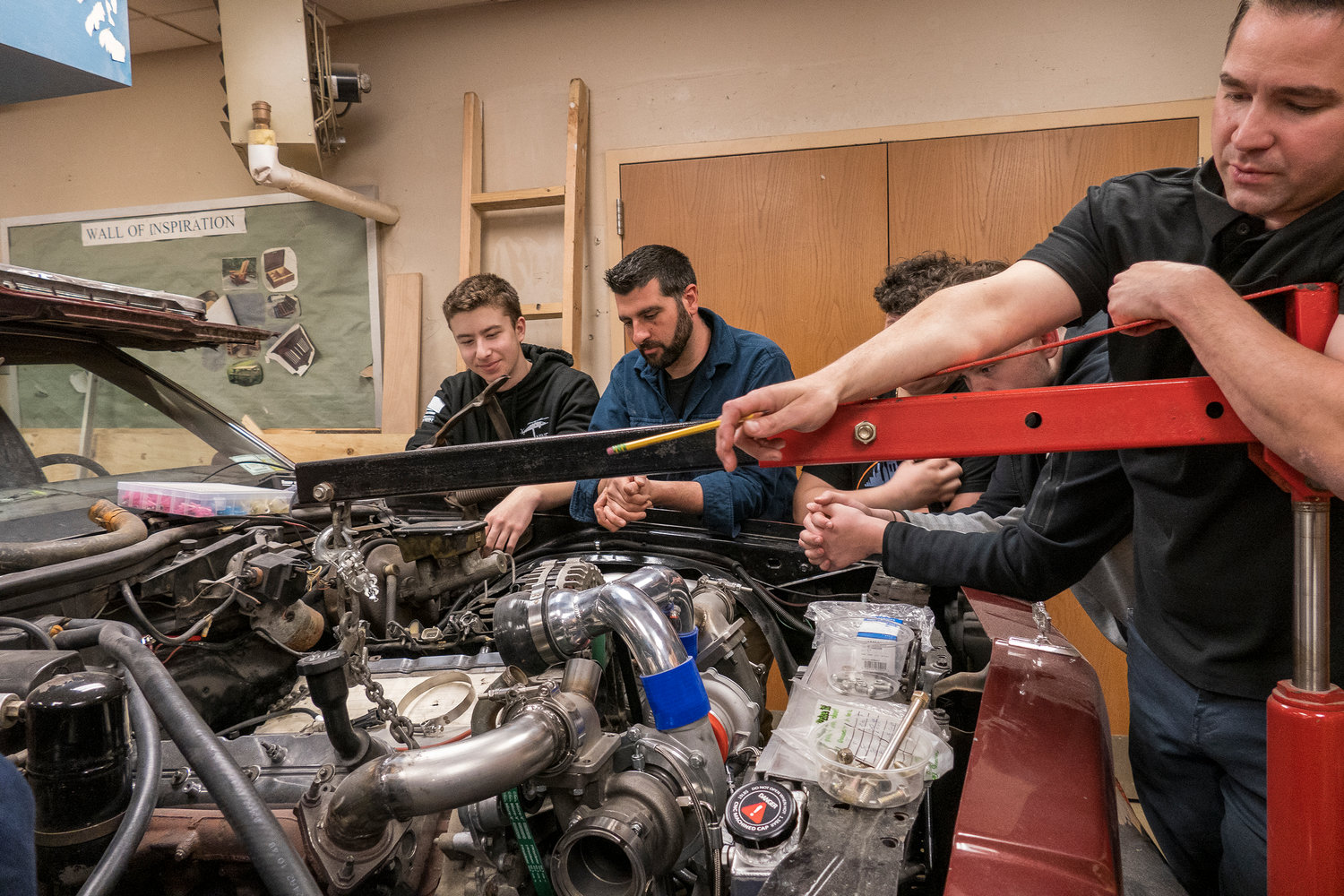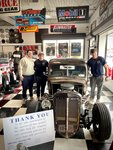‘The kids did everything’
Students get hands-on experience at Oceanside High School, building custom cars
The sounds of metalwork, woodwork and general tinkering can be heard coming from a woodshop in Oceanside High School dubbed the “dirty room.” In it sits a 1968 Chevrolet Impala that, after major upgrades, will be a totally different souped-up car thanks to the juniors and seniors in the advanced materials class. There students get a feel for hands-on skills that are useful in everyday life and, for those who don’t feel college is for them, a potentially lucrative, non-office-oriented future career.
Work on cars at the high school started last year, when advanced materials students built a “rat rod” truck — a custom vehicle deliberately left looking rough and unfinished, like something out of a “Mad Max” movie. Technology teacher John LaCascia, a car enthusiast, searched online and found the perfect shell of a truck to modify in Connecticut. He brought it back to Oceanside, and then, he said, “The kids did everything.”
Students welded the chassis together, built the engine, plumbed it, wired it, mounted it and built the bed for it. “Everything was built by hand,” LaCascia said.
Seniors Liam Sullivan and Alen Redzemphovic worked on the truck last year, and it is now on display at S-K Speed Racing Equipment in Lindenhurst. Sullivan, who isn’t a car guy, worked on the front axle where, he said, “There was a lot of folding — that’s all I remember.” He added that he likes to use his hands to create.
Redzemphovic said he “basically just worked on the body,” and that it was “good to learn a new skill” — welding.
For the Impala, which is this year’s big project, the floors were gutted, replaced and painted, the brakes rebuilt, and the rear end modified for a better rear axle. It now sports an engine and transmission from a 2003 GMC Yukon, and two turbochargers are in the works. “We’ve changed everything,” LaCascia’s fellow technology teacher, car enthusiast Sean Michel, said. “Everything in this car has been touched. We’re into this. We do this on our own free time, on top of showing these kids what to do.”
The Impala is expected to generate 600 to 800 horsepower when the work is done — all of it by OHS juniors and seniors. “It’s going to be quick,” LaCascia said, adding the class motto: “We do it right, because we do it twice.”
Two years ago, the technology teachers created a stand-alone class so that students interested in either construction or engineering could work on a big project. The goal for technology teachers LaCascia, Michel and P.J. Orlando is to expand the program each year, and along the way, inspire some of the students to become technology teachers.
LaCascia was the first one hired eight years ago. Now, with Michel and Orlando as well, the engineering and woodshop rooms are busy nine periods a day.
But not all technology programs are thriving. All three teachers are graduates of SUNY Oswego, one of the top producers of technology teachers, and they hope to instill in the students a love for trade skills that will help keep technology classes alive.
“First of all, there’s not a lot of technology teachers out there,” LaCascia said. “Districts are having a hard time finding people that teach the program. It can be a little bit of a liability issue for certain districts at times. And they’re expensive to run — you know, running this lab, there’s a huge amount more money than running an English department. So we need to be able to afford materials — wood, metal, plastic — there’s a lot to (making) this room run, and it’s all going up in price every year.”
At the same time, sending students to vocational schools like BOCES can be expensive, and there they don’t have the option of sampling the skills of a variety of trades, as students in high school programs do.
In fact, two students who worked on the rat rod and graduated last year are at SUNY Oswego studying to become technology teachers, and other recent graduates have become members of an ironworkers union.
The technology teachers visited their alma mater last year to take place in a technology conference last year, and gave a presentation titled “We Built a Rat Rod in a Woodshop” that was one of the most popular of the conference, attended by more than 80 people.
It was almost overwhelming to Michel, who said, “To have that many people pour into the auto shop for us, just to watch us talk about what we did last year — it was surreal. It was cool.”
The high school may only have the woodshop in which students can build, for now, but, Michel said, “We do a lot for what we have, as compared to some other schools. There’s not a lot of schools doing this with the cars.”
Harrison Feldman, a senior who is set to graduate, will head to SUNY Oswego next year. “Both of them are the reason I thought about doing the program,” he said of Michel and LaCascia. “I thought I could be good at it when they told me about it, and I did some research.”
“There’s different avenues, depending on what the kids want to do,” LaCascia said of life after high school. “Obviously, not everybody’s college made. There’s tons of ways that you can go jump into a trade, and because we’re in a metropolitan area, there’s tons of trades everywhere.”

 39.0°,
Fair
39.0°,
Fair 







